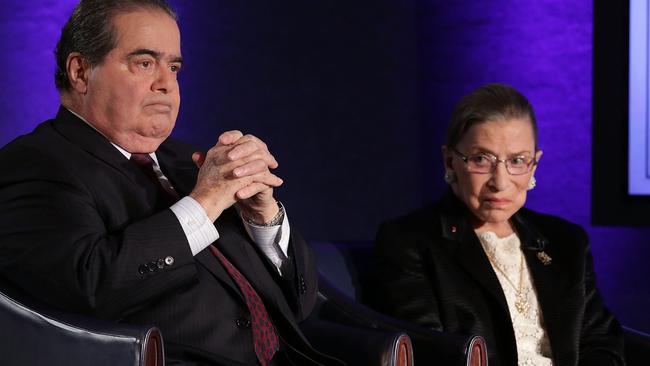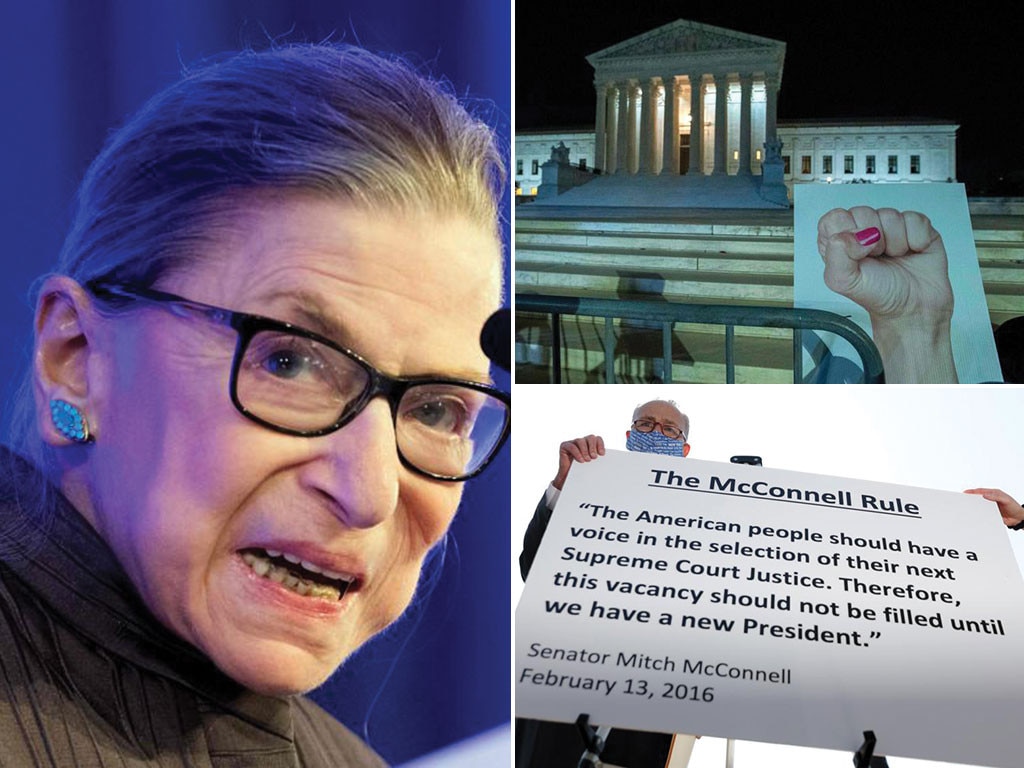Why Ruth Bader Ginsburg was my kind of feminist
Ginsburg’s advocacy for women’s rights was a million miles away from today’s lazy, shouty, sledgehammer feminists who fill bureaucracies and lobby groups.

Known as RBG in her later years, the 87-year-old US Supreme Court associate justice started out as the kind of feminist we should clone. She fought against sex discrimination before reaching the Supreme Court and her legacy is a feminism that is precise, incremental, rational and strategic. She was the first female tenured professor at Columbia Law School and co-founder of the Women’s Rights Project at the American Civil Liberties Union.
Case by case, Ginsburg fought for gender equity, winning five of the six cases she argued in the Supreme Court. She saw her role as an educator, not a zealot, who needed to persuade a male-dominated judiciary using clear, reasoned and irrefutable evidence that discrimination harmed women and men.
Ginsburg’s advocacy for women’s rights was a million miles away from today’s lazy, shouty, sledgehammer feminists who fill bureaucracies and the ranks of lobby groups such as Chief Executive Women. Take their demands for quotas and complaints about gender pay gaps. They never make passing mention, let alone conduct a careful appraisal, of why women’s choices should be part of any comparison of men and women in the workplace. Instead of using dodgy data that is easily demolished, they could do with a few pointers from RBG about the value of meticulous, rational and fair-minded argument.
Similarly, the #MeToo movement could learn something from RBG. Her feminism did not mean a departure from the rule of law and due process. Put simply, if more feminists fought the RBG way, gender equity for women and men would have deeper foundations.
In an address she gave before her nomination to the Supreme Court by Bill Clinton in June 1993, Ginsburg explained the importance of reform that united people rather than divided them.
She was critical of the decision in Roe v Wade because, instead of prudently and precisely striking down the Texas law, the majority carpet-bombed the democratic rights and responsibilities of all US state legislatures on abortion.
“Suppose the Court had stopped there, rightly declaring unconstitutional the most extreme brand of law in the nation, and had not gone on, as the Court did in Roe, to fashion a regime blanketing the subject, a set of rules that displaced virtually every state law then in force. Would there have been the 20-year controversy we have witnessed?” Roe v Wade “halted a political process (in favour of abortion rights) that was moving in a reform direction”, Ginsburg said, “and thereby, I believe, prolonged divisiveness and deferred stable settlement of the issue”. The Supreme Court turned abortion into a red-hot controversy that has not subsided one jot almost 50 years later.
The other learning from Ginsburg’s death is tailor-made for Australians. Measured in decibels, the frenzy over her replacement is off the political charts. Even an ocean away, we are enthralled by the mayhem. Yet when it comes to who will replace two of our own High Court judges due to step down in the next six months there are quiet murmurs in small corners of the nation.
Most Australians won’t know the names of Geoffrey Nettle, who turns 70, the mandatory retirement age, in December, followed by Virginia Bell in March next year. Nor will many Australians be able to recite the names of other current High Court judges. That is a fine and noble mark of a court that, mostly, understands its remit is not to become a political institution by concocting new law.
There are always a few blips, most recently the High Court’s deeply flawed, reverse-engineered decision in Love v Commonwealth of Australia and Thoms v Commonwealth of Australia this year. A majority of four to three decided that two Australian residents, born overseas and not Australian citizens, could not be deported because they had a special indigenous connection to the land. The poorly reasoned decision was rightly condemned by Chief Justice Susan Kiefel, who scolded the majority for dreaming up constitutional implications, drawing on personal preferences and acting “antithetical to the judicial function”.
Ginsburg’s death and the heated politics surrounding her replacement should be a reminder of just how lucky we are in this country that judgments of, and appointments to, our High Court are mostly the preoccupation of legal nerds.
The reason is simple: judges don’t have powers under a US-style bill of rights to act as legislators, usurping voters, doing what Americans call an end run around democracy by engineering legal and social outcomes that can’t be secured in congress. Not for nothing, abortion rights, for example, are dealt with sensibly in this country because voters get a say. Ditto same-sex marriage.
Remember that the next time some legal academic admonishes us for not being “progressive” by enacting a bill of rights. There is nothing remotely progressive about a system that rips off voters by politicising judges and necessarily turns judicial appointments into a macabre political circus.
Ginsburg offered her own reminder of that a few months before the 2016 presidential election when she said: “I can’t imagine what the country would be with … Donald Trump as our president.” She then proceeded to signal what decisions she would overturn. As The Wall Street Journal editorialised at the time, few judges have confirmed so openly why “so many Americans think the Supreme Court has become merely another political branch”.
Though Ginsburg apologised for her remark about Trump, to the end she didn’t stray far from politics. Take her dying wish “that I will not be replaced until a new president is installed”. By “new” Ginsburg no doubt meant a different president, a Democrat. If Ginsburg had felt that strongly about filling her seat with another left-liberal, she could have retired when Barack Obama was president. After all, RBG was 87 when she died and faced five bouts of cancer.
In any case, as one pundit noted last week, judicial appointments are decided by the US constitution, not by the Make-A-Wish foundation. The President can nominate a successor as soon as he wants and a Republican majority in the Senate has the power to confirm that appointment. From nomination to confirmation, Brett Kavanaugh’s SCOTUS appointment took 57 days. With less than 40 days to the US election, the Senate Republicans will put their skates on.
Amid the often feverish and unbalanced media coverage of this political extravaganza, including by our own ABC, all you really need to know is this: the court is an extension of politics, so much so that some Democrats have said they want to increase the number of judges from nine to 11 if they win the election; and Joe Biden and the Democrats would hurry to pick a new judge if the tables were turned.
There is yet another lesson from Ginsburg’s life. This one is especially hard to swallow for people who, as someone tweeted recently, indulge in performative mourning over her death but excommunicate friends and family who vote for Trump.
The woman dubbed the Notorious RBG, a cultural icon of the left-liberal establishment, was dear friends with Antonin Scalia, the conservative lion who believed that judges must honour the written words of the constitution. This legal odd couple formed an enduring friendship despite their legal differences during their 22 years together on the Supreme Court.
Though quiet and sombre in temperament, Ginsburg would pinch herself not to laugh at Scalia’s sassy courtroom asides. They went to the opera together, even appeared in one together. They celebrated New Year’s Eve together. “Scalia kills it and Marty (RBG’s husband) cooks it,” recalled a guest, former Bush solicitor general Theodore Olson.
“We were best buddies,” Ginsburg wrote after Scalia died in February 2016. Friendships are rarely forged like this today. Politics get in the way because it has become a substitute for morality. And a very poor substitute at that.
The most famous liberal on the court acknowledged that her legal jousting with the most famous conservative made her a better judge. “Justice Scalia nailed all the weak spots — and gave me just what I needed to strengthen the majority opinion,” Ginsburg said in a tribute to Scalia after his death.
Ginsburg was a great listener. How many of her most ardent mourners can say the same? In contrast to the sludgemakers and soupy offerings in today’s social media echo chambers, RBG and Scalia were the epitome of a healthy battle of ideas that strengthens not just a Supreme Court judgment but also a democracy.







Many on the left like to point out “teachable moments”. The life and death of Ruth Bader Ginsburg provide a truckload of them. Sadly, for hardliners on both sides of politics, they might be none the wiser. Regardless, let’s give it a go.